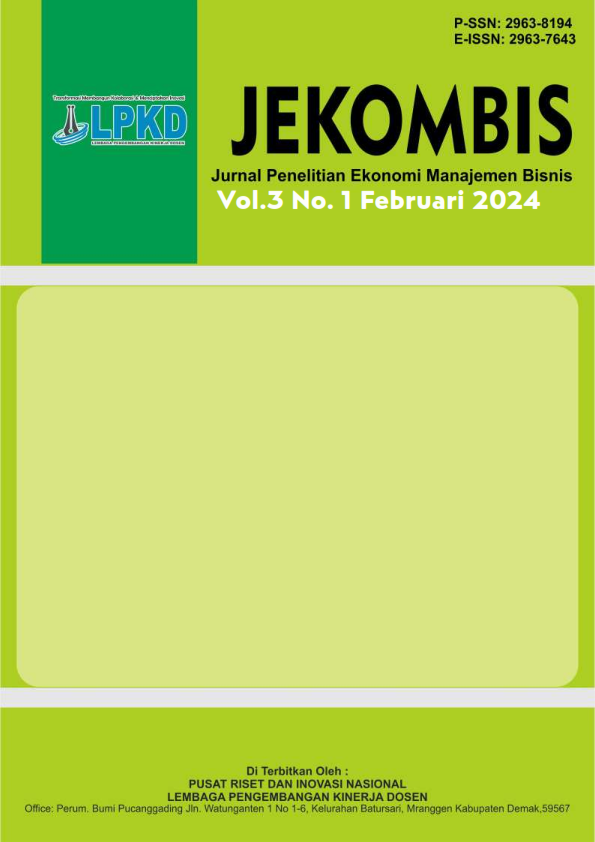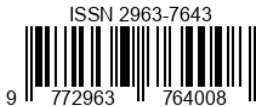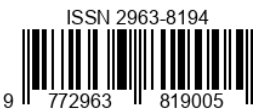Pemetaan Budaya Organisasi Pada Penggabungan Perguruan Tinggi di Bawah Satu Yayasan
DOI:
https://doi.org/10.55606/jekombis.v3i1.3429Keywords:
Culture Gap Higher, Education Organization merger, Organization CultureAbstract
The merging of Higher Education Organization has become the direction of guidance from the Ministry of Education and Culture in the context of improving the quality of higher education. In merging organizations, cultural differences are key elements that affect the effectiveness of the integration process. This research aims to map organizational culture in a private higher education which is the result of the merger of 2 academies . by a survey method. Data were taken using random stratification technique on 3 groups of employees from different organizations of origin. Organizational culture was measured using 24 questions Organization Culture Assessment Instrument (OCAI). The Kruskal Wallis test found that there were differences in the types of organizational culture in the three groups, the perceived organizational culture type was significantly different between the four types), and the expected type of organizational culture was different for the Clan, adhocracy, and Hierarchy types (p: 0, < 0.005) . Thus, this research show that the organizational culture of each group is stll relatively strong, and still shows difference in the type of culture expected in each group.
Downloads
References
Ahmad, W., Azam, T., Arshad, M., Ahmed, B., & Zaman, H. M. F. (2023). Faculty Members’ Perception of Learning Organization: A Case of Higher Education Institutions. SAGE Open, 13(1), 1–17. https://doi.org/10.1177/21582440231154409
Arlan, I. B., Syaifullah;, & Ahsyar, T. K. (2019). … Budaya Organisasi Terhadap Keberhasilan Implementasi Sistem Informasi Manajemen Rumah Sakit Menggunakan Ocai Dan Hot Fit. November, 101–108. http://repository.uin-suska.ac.id/20869/
Awaluddin, A. F., & Mahmud, B. (2022). the Role of Higher Education Culture in the Professional Development of Lecturers Through Religious Moderation Education (a Case Study of Student Organizations At Bone State Islamic Institute, Indonesia). Lentera Pendidikan : Jurnal Ilmu Tarbiyah Dan Keguruan, 25(2), 271–284. https://doi.org/10.24252/lp.2022v25n2i7
Aziz, S., Huda, N., & Kurniawan, L. A. (2022). Pengaruh budaya organisasi terhadap kinerja organisasi. Jurnal Manajemen Bisnis Dan Organisasi, 1(2), 337–340.
Báez, N. Á., & Arredondo, E. M. (2019). Academic Productivity and Political Culture: The Challenges of Higher Education Nowadays. Journal of Applied Business and Economics, 21(7), 73–89. https://doi.org/10.33423/jabe.v21i7.2548
Boateng, A. (2006). The role of culture in the merger and acquisition process: Evidence from the European chemical industry. Management Decision, 44(10), 1405–1421. https://doi.org/10.1108/00251740610715722
Borlaug, S. B., Tellmann, S. M., & Vabø, A. (2023). Nested identities and identification in higher education institutions—the role of organizational and academic identities. Higher Education, 85(2), 359–377. https://doi.org/10.1007/s10734-022-00837-5
Cameron, K. S., & Quinn, R. E. (2006). Diagnosing and changing organizational culture : based on the competing values framework. In Jossey-Bass A Wiley Imprint. Jossey-Bass A Wiley Imprint.
Desi, S. (2021). Kemendikbudristek: Ada 336 Kampus Swasta Terancam Merger. Kompas. https://www.kompas.com/edu/read/2021/04/30/144119871/kemendikbudristek-ada-336-kampus-swasta-terancam-merger?page=all.
Ehsanifar, M., Dekamini, F., Khazaei, M., Birau, R., Filip, R. D., & Ninulescu, P. V. (2023). Paradox Resolution Tactics in the Sustainable Organization Culture Through Interviews and Text Mining: A case Study of Education. Revista de Științe Politice. Revue Des Sciences Politiques, 78, 9–26. files/685/Ehsanifar et al. - Paradox resolution tactics in the sustainable orga.pdf
Fanya, B., Kadiyono, A. L., & Ashriyana, R. (2021). Analisis Budaya Organisasi Menggunakan Organizational Culture Assessment Instrument (OCAI) pada PT. X. MUKADIMAH: Jurnal Pendidikan, Sejarah, Dan Ilmu-Ilmu Sosial, 5(1), 63–69. https://doi.org/10.30743/mkd.v5i1.3450
Fauzi, F. (2019). Transformasi Budaya Organisasi pada Perguruan Tinggi Keagamaan Islam Negeri. Jurnal Manajemen Dan Pendidikan Islam, 5(1), 849. http://www.nber.org/papers/w16019
Gillis, T. (2011). The IABC Handbook of Organizational Communication. In A Guide to Internal Communication, Public Relations, Marketing, and Leadership. http://books.google.de/books?id=UZtexddHN8UC&printsec=frontcover&dq=oragnizational+communication&hl=&cd=16&source=gbs_api
Habudin. (2020). Budaya Organisasi Habudin. Jurnal Literasi Pendidikan Nusantara, 1(1), 23–32.
Han, L., Xu, H., & Zhong, Y. (2022). Education resource reallocation and innovation: Evidence from university mergers in China. China Economic Quarterly International, 2(4), 265–277. https://doi.org/10.1016/j.ceqi.2022.11.003
Hariyani, I., Serfianto;, & Serfiani, C. Y. (2011). Merger, Konsolidasi, Akuisisi, dan Pemisahan Perusahan. VisiMedia.
Harkin, D. G., & Goedegebuure, L. (2020). Exploring the potential for mergers and strategic partnerships within the Australian higher education system through the application of Value Nets. Journal of Higher Education Policy and Management, 42(4), 458–477. https://doi.org/10.1080/1360080X.2019.1701854
Harman, Grant ; Harman, K. (2003). INSTITUTIONAL MERGERS IN HIGHER EDUCATION:LESSONS FROM INTERNATIONAL EXPERIENCE. Tertiary Education and Management, 9, 29–44. https://doi.org/10.1007/978-3-319-13135-1_7
Heritage, B., Pollock, C., & Roberts, L. (2014). Validation of the organizational culture assessment instrument. PLoS ONE, 9(3), 1–10. https://doi.org/10.1371/journal.pone.0092879
Islam, M. S., Tseng, M. L., & Karia, N. (2019). Assessment of corporate culture in sustainability performance using a hierarchical framework and interdependence relations. Journal of Cleaner Production, 217, 676–690. https://doi.org/10.1016/j.jclepro.2019.01.259
Kusdi. (2011). Budaya Organisasi: Teori, Penelitian, dan Praktik. Penerbit Salemba.
Laksono, H., Majeri, H., Sukaesih, R., Hermawan, B., & Taufik. (2022). Peningkatan Mutu Pendidikan Madrasah Melalui Pembangunan Budaya Organisasi. Al-Afkar Journal for Islamic Studies, 5(3), 173–186.
Li, M., Qin, B., & Bai, Y. (2023). History and Reality of the Chinese Model of Higher Education Development from the Perspective of University Mergers. In Historia Provinciae - Zurnal Regional’noj Istorii (Vol. 7, Issue 2). https://doi.org/10.23859/2587-8344-2023-7-2-4
Liu, Q., Patton, D., & Kenney, M. (2018). Do university mergers create academic synergy? Evidence from China and the Nordic Countries. Research Policy, 47(1), 98–107. https://doi.org/10.1016/j.respol.2017.10.001
Locke, W. (2007). Higher education mergers: Integrating organisational cultures and developing appropriate management styles. Higher Education Quarterly, 61(1), 83–102. https://doi.org/10.1111/j.1468-2273.2006.00339.x
Mallak, L. A., & Kurstedt, H. A. (1996). Using culture gap analysis to manage organizational change. EMJ - Engineering Management Journal, 8(2), 35–41. https://doi.org/10.1080/10429247.1996.11414891
Maolani, M., & Rufaidah, A. (2023). Perumusan Budaya Organisasi Yayasan Pendidikan Kinantan Surabaya. Tadbir Muwahhid, 7(1), 109–131. https://doi.org/10.30997/jtm.v7i1.6373
Marwan;, Saputra, S., Chaerul, M. ;, Adi, S., Suseno, D. N. ;, Suseno, D. A., Gusty, S. ;, Sahabuddin, Andi Arfan; Siahaya, J. ;, & Deniyatno. (2020). Manajemen Kinerja dan Budaya Organiasai: Suatu Tinjauan Teoritis. (1st ed.). KITA MENULIS.
Mezcua, A. R., & del Carmen Valverde Ferrera, M. (2019). Interpreting to bridge the gaps in war conflicts. International Approaches to Bridging the Language Gap, 251–269. https://doi.org/10.4018/978-1-7998-1219-7.ch015
Muhidin, S. A., Hufad, A., Sutarni, N., Islamy, F. J., Rasto, R., & Inayati, T. (2022). Knowledge Management And Job Performance in Higher Education: The Role Of Leadership and Organizational Culture. AL-ISHLAH: Jurnal Pendidikan, 14(4), 5155–5168. https://doi.org/10.35445/alishlah.v14i4.1765
Nidya Dudija. (2018). Strategi_Penanganan_Konflik_pada_Proses_Penggabung. Psikohumaniora, 3, No.1, 37–58. https://journal.walisongo.ac.id/index.php/Psikohumaniora
Nirmala, I., & Attamimi, A. N. R. (2017). Statistik Pendidikan Tinggi. Pusat Data dan Informasi Ilmu Pengetahuan, Teknologi, dan Pendidikan Tinggi Kementerian Riset, Teknologi, dan Pendidikan Tinggi Republik Indonesia.
Nurjanah. (2021). Analisis Pengaruh Kepemimpinan dan Budaya Organisasi Terhadap Kinerja Pegawai Perguruan Tinggi. Jurnal Manajemen Bisnis Dan Organisasi, 2(1), 42–52. https://osf.io/preprints/2bfvh/
Poutanen, M. (2023). Competitive knowledge-economies driving new logics in higher education–reflections from a Finnish university merger. Critical Policy Studies, 17(3), 390–408. https://doi.org/10.1080/19460171.2022.2124429
Quinn, R. E., & Rohrbaught, J. (1983). A Spatial Model of Effectiveness Criteria : Towards A Competing Vallues Approach to Organizatioanl Analysis. Management Science, 29(4), 362–377.
Saputra, N., Maulida, F., & Dewanto, P. E. (2022). Mengupas Pengaruh Kompetensi Individu dan Budaya Organisasi terhadap Kinerja Karyawan pada Perusahaan e-Commerce di Indonesia. Aksara: Jurnal Ilmu Pendidikan Nonformal, 8(1), 179. https://doi.org/10.37905/aksara.8.1.179-186.2022
Serfiyani, C. Y. (2020). Restrukturisasi Perguruan Tinggi Swasta Sebagai Upaya Penyehatan Dan Peningkatan Kualitas Institusi. Jurnal Hukum Ius Quia Iustum, 27(2), 410–433. https://doi.org/10.20885/iustum.vol27.iss2.art10
Setiawan, F. A., & Suhaji, S. (2020). Pemetaan Budaya Organisasi pada Perusahaan Keluarga Menggunakan OCAI (Organizational Culture Assesment Instrument). Jurnal Ilmiah Aset, 21(2), 71–85. https://doi.org/10.37470/1.21.2.148
Simamora, B. H., & Jerry, M. (2013). Current and preferred organizational culture: A case study at private university in Indonesia. In International Business Management (Vol. 7, Issue 4, pp. 353–358). https://doi.org/10.3923/ibm.2013.353.358
Slade, C. P., Ribando, S., Fortner, C. K., & Walker, K. V. (2022). Mergers in higher education: it’s not easy. Merger of two disparate institutions and the impact on faculty research productivity. Studies in Higher Education, 47(6), 1215–1226. https://doi.org/10.1080/03075079.2020.1870948
Slamet, Y. (2001). Teknik Pengambilan Sampel Untuk Penelitian Kuantitatif dan Kualitatif. PT Pabelan.
Sutopo, H. (2012). Perilaku Organiasi, Teori dan raktik dalam bidang pendidikan. Remaja Rosdakarya.
Syarifuddin, S., Afrizayanti, & Afdal, A. (2022). INISIATIF Culture Health Index: Mengukur Tingkat Kesehatan Budaya Organisasi BPJS Kesehatan. Jurnal Jaminan Kesehatan Nasional (JJKN), 2(2), 159–178. https://doi.org/10.53756/jjkn.v2i2.109
Ulviana Siwi, T. P., & Nawawi, Z. (2023). Pengaruh Kepuasan Kerja Terhadap Perilaku dan Budaya Organisasi Perusahaan. JPPI (Jurnal Penelitian Pendidikan Indonesia), 9(1), 523–529. https://doi.org/10.29210/020232124
Downloads
Published
How to Cite
Issue
Section
License
Copyright (c) 2023 Jurnal Penelitian Ekonomi Manajemen dan Bisnis

This work is licensed under a Creative Commons Attribution-NonCommercial-ShareAlike 4.0 International License.







